Adaptive Aqua Zumba games provide inclusive, therapeutic movement for special needs participants. Try Floating Rhythmic Ribbons for sensory engagement, Gentle Wave Dance for low-impact movement, Underwater Treasure Catch for motor skills, Noodle Zumba for supported choreography, and Splash Beat Circle for group coordination. Additional options include Aquatic Simon Says, Musical Water Hoops, Partner Pool Patterns, and Sensory Splash Beats. These water-based activities offer physical benefits while creating a joyful environment where everyone can shine through movement.
Floating Rhythmic Ribbons: Sensory Movement in Water
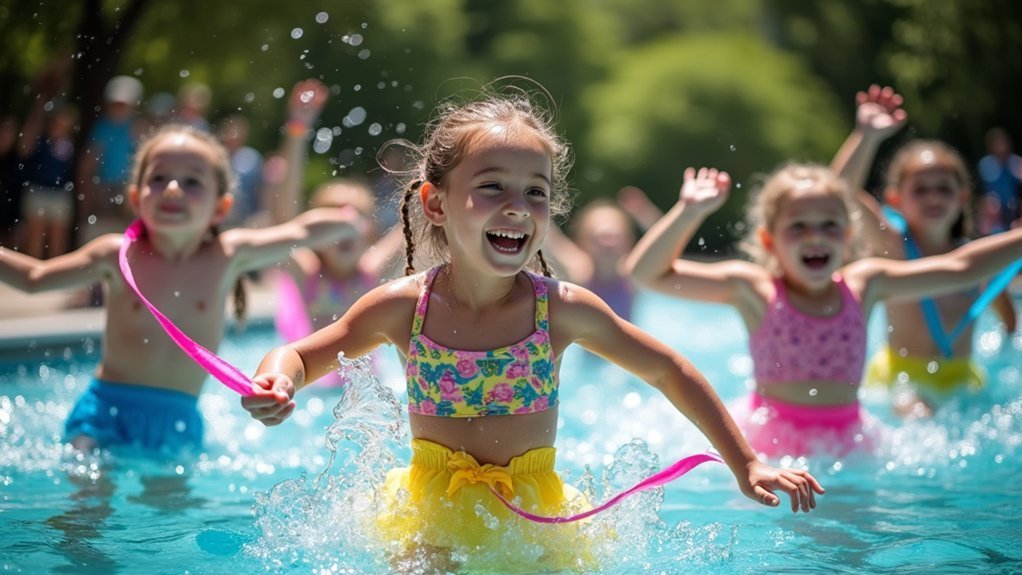
When vibrant ribbons dance through water, they create a magical sensory experience that’s uniquely beneficial for individuals with special needs. These waterproof ribbons enhance both visual and tactile engagement while encouraging playful movement that improves motor skills and creativity.
You’ll need water-resistant ribbons, floating structures, waterproof music systems, swivel attachments, and buoyant handles for the best experience. For safety, always guarantee proper supervision, clear pool area guidelines, and appropriate flotation devices for participants.
Integrating floating rhythmic ribbons with Aqua Zumba creates opportunities for coordinated movement to music, group interaction, and personalized modifications. Consider adding the Ribbons & Rhythms CD with its limited supply to provide the perfect musical accompaniment for these water-based activities.
The therapeutic benefits are substantial—stimulating neurological development, enhancing emotional expression, and strengthening motor skills through repetitive, joyful movements. This adaptable activity accommodates diverse abilities while reducing stress and promoting cognitive development.
Gentle Wave Dance: Low-Impact Zumba Adaptations
Unlike traditional high-impact exercises, Gentle Wave Dance transforms Aqua Zumba into a therapeutic movement experience that perfectly suits individuals with special needs. The choreography emphasizes flowing, natural movements that allow you to express yourself within your comfort zone.
You’ll enjoy the calming atmosphere created by soft, melodic music selections that promote both physical activity and mental well-being. Each session includes carefully designed warm-ups and cool-downs to enhance flexibility while encouraging relaxation.
What makes Gentle Wave Dance particularly accessible is its thoughtful structure with periodic breaks that accommodate diverse energy levels. The program is gentle on joints while still providing an effective workout that enhances your physical health. The water’s buoyancy naturally reduces joint strain while providing resistance that enhances muscle toning.
You’ll find these adaptations create an inclusive environment where everyone can participate regardless of mobility limitations.
Underwater Treasure Catch: Motor Skills Enhancement

You’ll need floating objects in bright colors, weighted dive toys, and mesh collection bags to customize the underwater treasure catch for different ability levels.
Start with larger, easily retrievable items near the surface before progressing to smaller objects or those requiring deeper reaching movements.
As participants develop confidence, you can introduce timed challenges or specific collection patterns to enhance both fine and gross motor coordination while maintaining the enjoyable treasure-hunting experience. This activity significantly improves hand-eye coordination as participants must visually track objects in water while adjusting their movements to retrieve them.
Equipment Modifications Needed
Successful implementation of the Underwater Treasure Catch game requires specific equipment adaptations to accommodate participants with diverse abilities. You’ll need adjustable water resistance devices and customizable grips that enable easier handling for participants with varying dexterity levels. The natural resistance of water during gameplay provides an effective yet gentle way to build muscle strength for participants with disabilities.
| Modification | Emotional Benefit |
|---|---|
| Floatation supports with added stability | Security and confidence |
| Multifunctional equipment for arm/leg use | Pride in versatility |
| Customizable grip sizes | Independence and control |
| Assistive technology integration | Feeling included and supported |
Consider integrating compression vests for additional support while maintaining fun. Remember to incorporate buoyancy devices that help maintain comfort during the treasure hunt. These modifications don’t just make the game accessible—they transform it into an engaging experience where everyone can participate successfully regardless of ability level.
Progressive Skill Building
Progressive skill building in the Underwater Treasure Catch game transforms ordinary pool activities into powerful developmental opportunities for participants with special needs.
You’ll notice both fine and gross motor skills develop as players retrieve submerged objects, strengthening muscles through water’s natural resistance.
Start with larger, brightly colored objects at shallow depths, gradually introducing smaller items and increasing depth as skills advance. This progression naturally enhances hand-eye coordination and balance while providing valuable tactile sensory integration.
The game’s adaptability makes it ideal for diverse abilities – some participants might wade while others swim or use flotation devices. Water allows participants to experience cognitive skills development through engaging retrieval challenges that require strategic thinking.
As players strategize retrieval methods, they’re simultaneously developing problem-solving skills and experiencing cause-effect relationships. The collaborative nature encourages communication and social interaction, making this activity beneficial across multiple developmental domains.
Noodle Zumba Moves: Supported Water Choreography
The vibrant world of Noodle Zumba opens up exciting possibilities for special needs participants through uniquely adapted water choreography.
You’ll find these movements are incredibly adaptable, with pool noodles providing essential support and resistance.
Start with basic steps like forward and backward movements while holding the noodle for stability. Position noodles under arms or across your body depending on the exercise. You can incorporate modified arm gestures similar to traditional Zumba while engaging your core for balance. Participants enjoy the Latin dance elements while benefiting from the low-impact nature of water exercises.
As you progress, you’ll experience various dance influences from salsa to cha-cha, adapted for water. The choreography uses visual cues and verbal reminders to help you stay in sync.
Splash Beat Circle: Group Coordination Activities
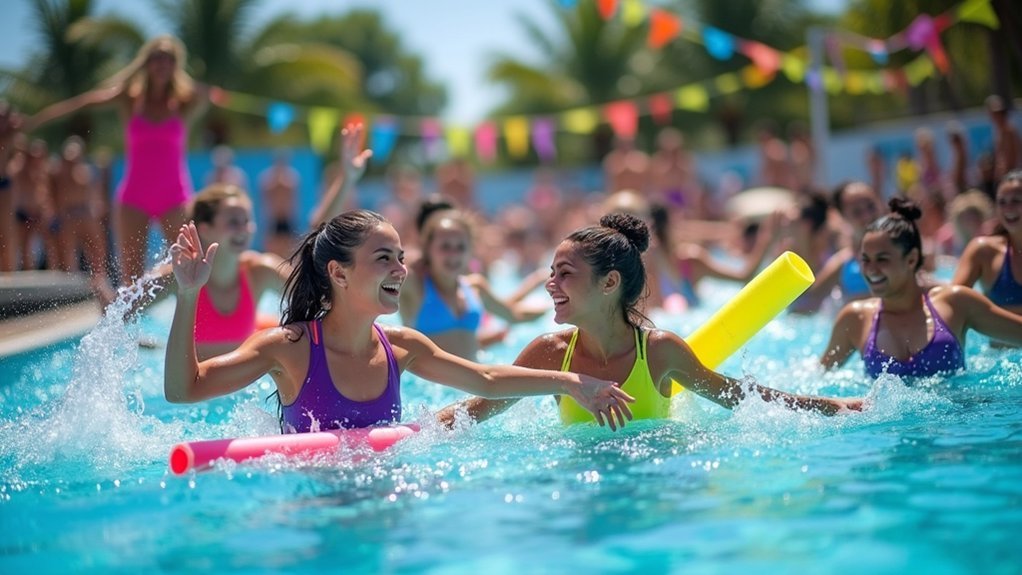
Splash Beat Circle activities transform group coordination into a vibrant aquatic symphony that builds trust and rhythmic awareness.
Form a circle in the pool with participants standing arm’s length apart, then create rhythmic patterns by splashing water in sequence.
You’ll notice how water resistance adds a unique challenge, requiring you to adapt your movements while maintaining the group’s rhythm.
Start with simple patterns before progressing to more complex sequences where you’ll incorporate body turns and level changes.
For participants with special needs, modify movements to match individual abilities—some may splash with hands while others use noodles or kickboards.
Focus on the collaborative experience rather than precision.
The activity’s sensory elements—water splashing, sound patterns, and visual cues—create an inclusive environment where everyone can succeed regardless of physical limitations.
This aquatic activity draws inspiration from land-based exercises like Connecting Circle, where holding hands throughout the activity promotes unity and connection among participants.
Buoyancy Balance Challenges: Core Strengthening Games
Harnessing water’s natural resistance, buoyancy balance challenges create an ideal environment for developing core strength while minimizing joint stress.
You’ll find these exercises reduce weight-bearing stress by up to 90%, making them perfect for participants with special needs who benefit from the water’s supportive nature.
The center of buoyancy helps stabilize participants during balance training by counteracting gravitational forces.
When implementing core strengthening games, consider these essential elements:
- Adjust water depth to modify exercise intensity – deeper water provides more support while shallow sections increase difficulty
- Incorporate equipment like noodles and kickboards to enhance resistance and engagement
- Create turbulent conditions strategically to challenge balance capabilities while maintaining safety
These activities not only strengthen physical abilities but also reduce anxiety about falling, boost self-confidence, and promote social interaction—delivering both physical and psychological benefits in an engaging, accessible format.
Aquatic Simon Says: Following Directions Through Movement
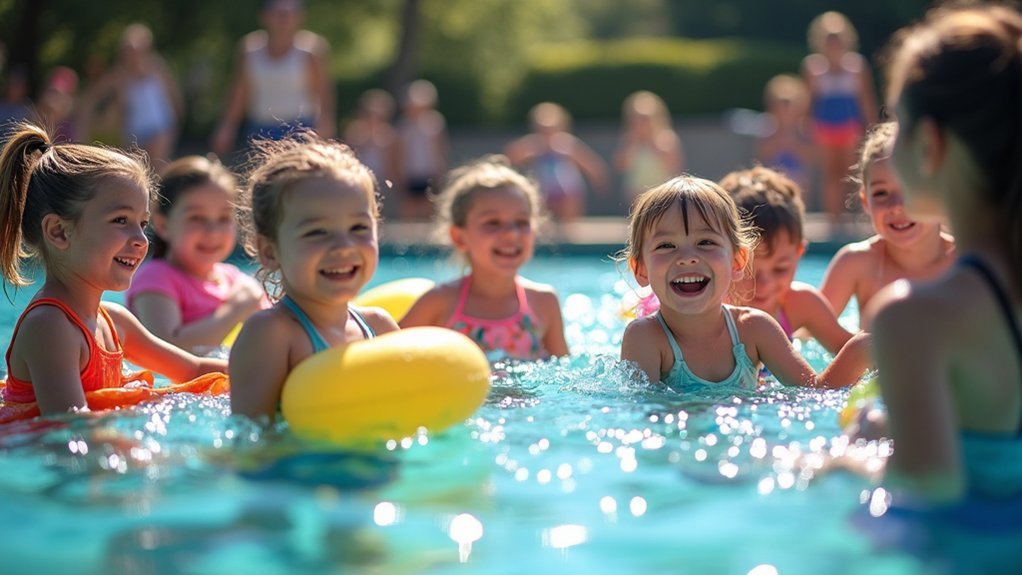
Combining cognitive processing with physical movement, Aquatic Simon Says transforms traditional direction-following into an immersive therapeutic experience for special needs participants.
You’ll notice improved sensory integration as your child processes visual and auditory commands in water’s unique environment.
This adaptable activity builds motor planning skills while water’s buoyancy reduces injury risk during physical play.
The game’s structure helps with behavioral management and anxiety reduction while creating opportunities for social interaction among diverse participants.
You can tailor instructions to accommodate different abilities, incorporating multisensory cues for enhanced engagement.
Water’s proprioceptive feedback improves body awareness and spatial sense as participants respond to commands.
The play-based learning approach makes therapy enjoyable while developing listening skills and emotional regulation in a supportive, inclusive setting.
Many parents report significant progress in their children’s ability to trade toys and interact socially through supervised sessions that naturally foster interpersonal skills.
Musical Water Hoops: Adaptive Navigation Exercises
Musical Water Hoops offers another exciting aquatic option that transforms traditional game concepts into therapeutic practice.
You’ll create an engaging environment using colorful pool noodles or water-friendly hoops strategically placed in shallow water as destinations for participants.
When implementing this activity, focus on:
- Safety first – Maintain appropriate staff ratios, use flotation devices when needed, and assess each participant’s abilities before starting.
- Sensory engagement – Combine music cues with visual markers to stimulate multiple senses during navigation exercises.
- Adaptive movements – Encourage various locomotion techniques including walking, swimming, or assisted floating based on individual capabilities.
This activity builds reaction time, balance, and social interaction skills while participants navigate to their designated hoops when the music stops, creating an accessible challenge for all ability levels. Participants should practice keeping eyes up during movement to prevent collisions with others in the pool.
Partner Pool Patterns: Collaborative Water Routines
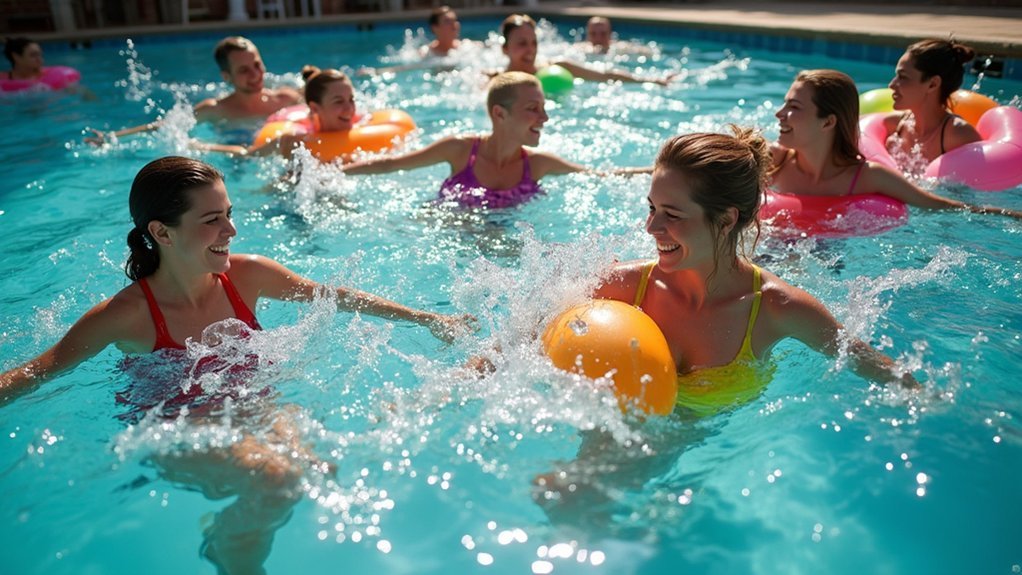
When participants engage in partner-based aquatic activities, they experience benefits beyond individual exercise routines. These collaborative patterns enhance coordination and teamwork while building confidence in a supportive environment.
You’ll find that strategic pairing of participants maximizes enjoyment and learning. Simple choreography with modified moves guarantees everyone can participate regardless of ability level. Music cues help guide dancers through salsa, mambo, and other dance styles while maintaining engagement.
Strategic pairing and simplified choreography create an inclusive environment where everyone thrives, regardless of ability level.
Instructors can provide physical guidance when needed, all while maintaining the class flow. The water’s natural resistance creates an ideal low-impact environment for strength training without stressing joints. The low-impact nature of Aqua Zumba makes it particularly suitable for individuals with joint concerns while still delivering an effective workout.
This approach allows for customization based on individual capabilities while fostering social interaction and community building—important aspects of any adaptive program.
Sensory Splash Beats: Percussion and Movement Therapy
You’ll discover the therapeutic impact of underwater drum circles where participants create rhythms while partially submerged, amplifying sensory feedback through water’s natural resistance.
Water’s unique acoustic properties transform ordinary percussion into multisensory experiences that benefit coordination and sensory integration for special needs participants. This approach draws from techniques similar to Sensory Percussion, where machine learning technology helps capture the nuances of different playing styles and interactions with the water’s surface.
Try matching your body movements to specific drum beats in the water, creating a synchronized therapy experience that engages both the vestibular and proprioceptive systems simultaneously.
Drum Circles Underwater
Diving into the innovative domain of underwater percussion, drum circles create a uniquely immersive therapeutic experience for individuals with special needs.
You’ll discover how water’s natural properties enhance the sensory impact of drumming, as sound waves travel differently underwater, creating vibrations you can feel throughout your body. Participants can experience the calming effect similar to an ocean drum sound while immersed in water.
Specialized waterproof instruments allow participants to engage in rhythmic expression while benefiting from water’s therapeutic qualities:
- Reduced joint stress – Water’s buoyancy supports movement while providing gentle resistance
- Enhanced sensory integration – Combines auditory, visual, and tactile stimulation simultaneously
- Increased social connection – Shared rhythmic experiences foster communication and belonging
These underwater sessions transform traditional aquatic therapy by incorporating the cognitive benefits of music with movement, creating a multisensory environment where participants can express themselves freely.
Beat-Matching Water Movements
Have you ever witnessed the transformative power of synchronized movement and music in water? Sensory Splash Beats marries percussion with aquatic movement to create a therapeutic experience that’s both engaging and beneficial.
You’ll see participants connecting with rhythm as they move through water’s natural resistance. This approach mirrors how Sensory Percussion enhances traditional drumming, creating responsive experiences that respect individual nuances and abilities. This technique provides rich tactile feedback, stimulating sensory receptors while improving motor skills and emotional regulation.
The water carries vibrations, enhancing sensory integration for special needs participants in particular. You can incorporate aquatic percussion instruments to guide synchronized movements, making the activity accessible for various ability levels.
It’s a low-impact option that accommodates diverse mobility needs while building community connections. The beauty of Beat-Matching Water Movements lies in its adaptability—participants experience joy while developing skills through music and movement.
Frequently Asked Questions
How Can Non-Swimmers Participate in Adaptive Aqua Zumba Safely?
You can safely participate in adaptive aqua zumba as a non-swimmer by using flotation devices, staying in shallow water, communicating your comfort level, and working with instructors trained in adaptive techniques and water safety.
What Water Temperature Is Ideal for Special Needs Participants?
For special needs participants, you’ll want water between 83-86°F for general comfort. If you’re working with those needing therapy, aim for 91-95°F. Remember, those with MS prefer cooler water (80-84°F).
Are There Age Restrictions for Adaptive Aquatic Programs?
Age restrictions for adaptive aquatic programs vary widely. While many accept children of all ages, some structured group classes require participants to be at least three years old. You’ll find most programs base eligibility on individual needs rather than age.
How Are Seizure Risks Managed During Water Activities?
You’ll manage seizure risks with one-on-one supervision, required flotation devices, and swimming in shallow areas. Always inform lifeguards about your condition, wear medical alert jewelry, and swim with a knowledgeable companion who understands seizure response.
Can Wheelchair Users Transition Into Pool Activities Independently?
Yes, you can shift independently using properly designed pool ramps, portable lifts, or transfer systems. With accessible features and proper training, you’ll gain confidence maneuvering from your wheelchair into water activities safely.
In Summary
You’ve now got ten fantastic aqua Zumba games to transform your special needs water fitness program. Remember, you don’t need complex equipment or advanced training to make these activities work. Just adapt each game to your participants’ abilities and celebrate their progress. By combining water’s natural support with rhythmic movement, you’re creating a fun, therapeutic environment where everyone can succeed at their own pace.

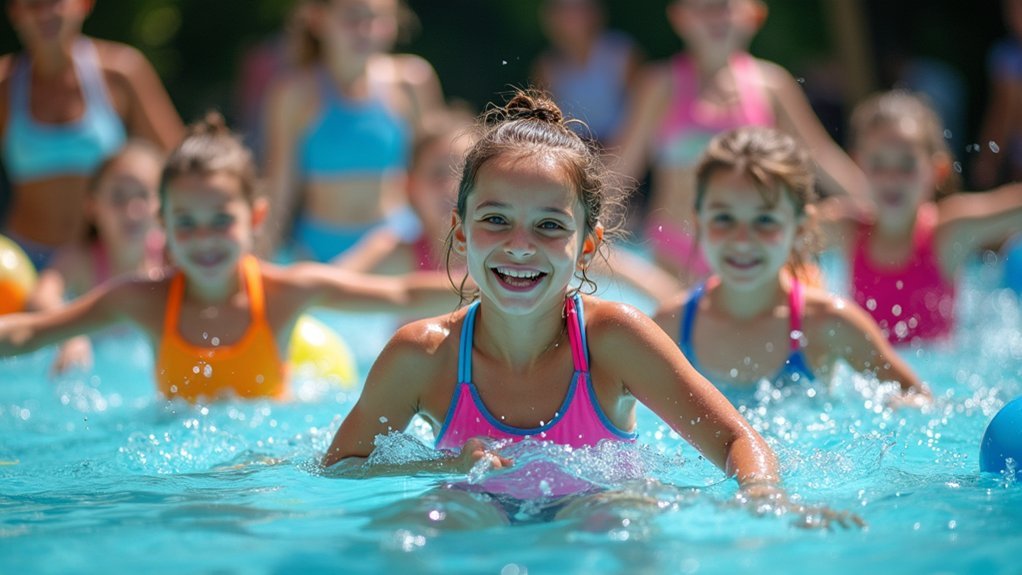



Leave a Reply